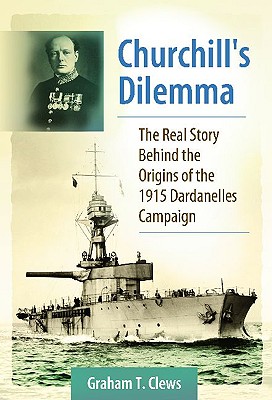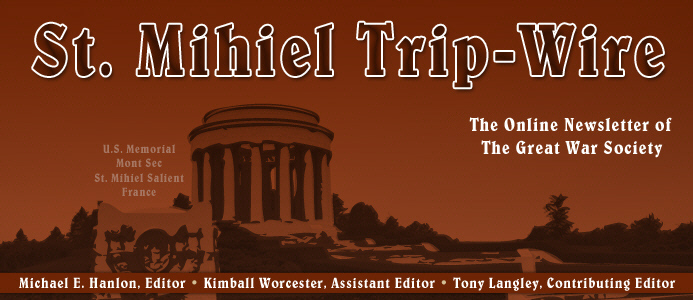

TRENCH REPORT: This is being presented a little early this month. Your editor is off to lead his annual tour of the Western Front. Two new items on this year's itinerary: the site of poet Alan Seeger's Rendezvous at Belloy-en-Santerre and the recent discoveries at Fromelles. Report and photos next month. Byeee!
MH
This Month's Internet Feature
Meet O'Brien Browne
One of the most dedicated World War I historians today is Michael O'Brien Browne, an American businessman living in Heidelberg, Germany. He has written frequently for Relevance, Over the Front, MHQ, and a host of other periodicals. Here is a sampling of his work:
The Red Baron's Triplane
Mick Mannock
Ernst Udet
The Problem Is Iraq's Borders
Voices from Verdun
Lawrence and the Arab Revolt
New at Our Own & Our Friends' Great War Websites
Click on Title or Icon to Access
|
Our film and video columnist has found a great site that includes films of Anzacs at Egypt, Gallipoli, Messines, and after the war (this is the alphabetical listing):
At Great War Society Sites
Researching World War I? Take advantage of our Researchers "Gadgets"
At WFA-USA Sites
|

Winston Churchill's closest visit from Death during his service on the Western Front came when he was called to the rear for a meeting with a general. Returning, disgusted that the meeting never took place, he discovered that the shelter he had vacated was destroyed by artillery fire minutes after he had departed.
From:
Forty Ways to Look at Winston Churchill.
|
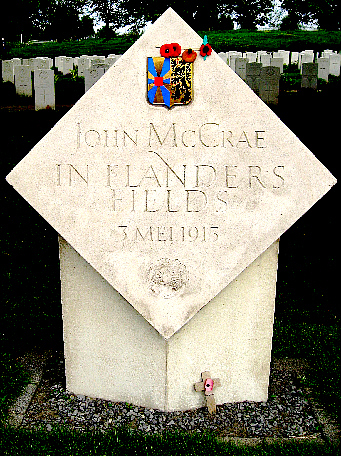
Marker at Essex Farm, Flanders
Where McCrae Composed "In Flanders Fields"
|
GREAT WAR 2011 EVENT CALENDAR
|
A World War I Event Calendar
Download Word Document Calendar
Here
We have resumed maintaining our WWI Calendar. There is simply more information than we can display here on the Trip-Wire. We count on all of you who schedule WWI events to contact us with new and updated information.
(send an email with schedule information)
|
National World War I Seminar
The Soon to Be
World War One Historical Association presents:
War Art & the Art of War
9-10 September, 2011
Citi-Garden Hotel
South San Francisco, CA
Near S.F. International Airport
(Download Program and Registration Form)
|
Western Front Association
U.S. Branch Chapter Meetings
Check for Your Region
Regularly Updated (details)
|
Great War Society Monthly Chapter Meetings
Berkeley, San Francisco, and
Palo Alto, CA
Regularly Updated (details)
|
Upcoming Events at the National World War I Museum
Kansas City, MO
New Exhibits and Lectures Scheduled
Regularly Updated (details)
|
Send additions/corrections for our master schedule:
Email Response
|
Wanted to Trade: Your self-published World War I (or other) books for my WWI book, Dear Homefolks. It is the story of my father's transition from farmer to his encounter with the AEF as a truck mechanic and after the war a hospital patient following a railway accident in France. Contact: Dale Thompson dale_thomp@sinewave.com
|

. . .Each of us has only the one wish, that is should soon come to a final reckoning with this gang, to an attack at all cost, and that those of us who will possess the happiness of seeing the homeland again will find it purer and more purified of foreigness, that through the sacrifices and suffering which many hundreds of thousands of us are daily undergoing, that through the river of blood which here flows day by day against an international world of enemies, not only Germany's external enemies will be shattered, but our inner internationalism too will break.
Letter, 15 February 1915
Adolph Hitler
|
|
|
|
Page Two
|
|
|
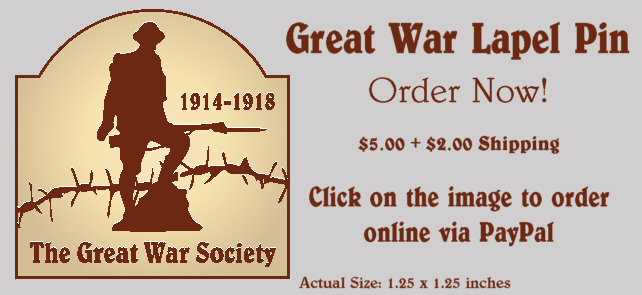 |
|
|
|
A friend of our WWI organizations, Lisa Budreau, PhD, has been appointed Vice President of Collections and Education & Chief Historian at the National World War I Museum. She has spoken at several WFA-USA seminars, and her influential book Bodies of War: World War I and the Politics of Commemoration in America, 1919-1933 (New York University Press, 2010) is going into its second printing. She had this to say about her new position:
“From my perspective, this state-of-the art museum represents an unsurpassed national treasure with great creative possibilities and fresh potential. I look forward to helping the United States’ official World War I museum prosper and shine in the national spotlight.”
Good luck, Lisa, with this very important job for the World War I community.
|
|
|
Monet's Paris World War I Memorial
Water Lilies at Musée de l'Orangerie |
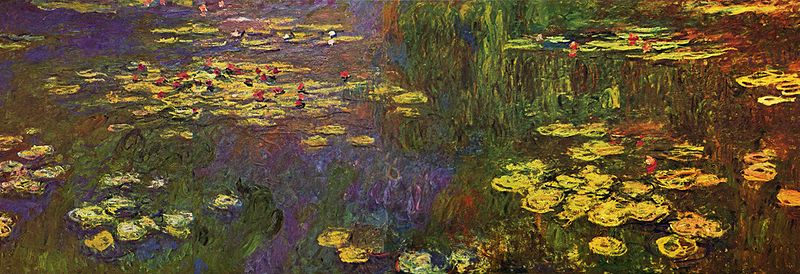
One of the most beautiful memorials to the Great War -- a series of enormous canvases by the Impressionist master Claude Monet (1840–1926) can be viewed at the Musée de l'Orangerie in Paris.
Water Lilies (or Nympheas) is a series of approximately 250 oil paintings by Monet. The paintings are on display at museums all over the world. They depict the artist's flower garden at Giverny and were the main focus of Monet's artistic production during the last 30 years of his life. Many of the works were painted while Monet suffered from cataracts.
Monet offered a set of Water Lilies to his friend President Georges Clemenceau the day after the Armistice that ended World War I on 11 November 1918. He gave them to the nation as "a monument to peace, military peace that ended the Great War, but also the interior peace of man". During the 1920s, France built a pair of oval rooms at the Musée de l'Orangerie as a permanent home for eight "Water Lily" murals by Monet. The exhibit opened to the public on 16 May 1927, a few months after his death.
(Suggested by members Diane Rooney and Alice Horner)
|
|
World War I Headlines
in the
21st Century
|
|

Soldiers and Sailors in Advertising
Certain Things in Life Are Constants
|
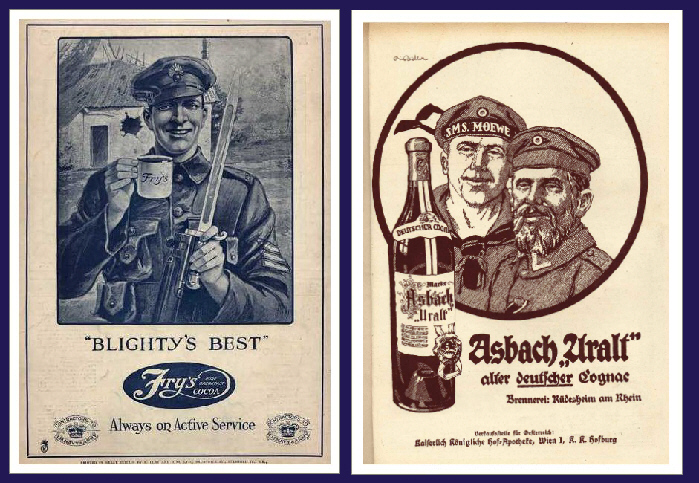
|
Click Here to Visit the Website of Our Contributing Editor Tony Langley
War in a Different Light

|
|
Subscribe to Our Online Magazine
|
|

|
|
|
Page Three
|
|
|
Dr. Steven E. Anders, Quartermaster Corps Historian
Back in the bad old days, life in the army could get, well, downright lousy. An estimated 90 percent of the frontline troops in Word War I suffered from lice infestation -- more commonly known as "Cooties".

Doughboys "Reading Their Shirts" for Cooties
Without proper field sanitation, lice spread quickly from one soldier to another. Hence, it took very little time for the uninitiated to begin slapping, scratching, and nitpicking along with the rest. Alas, it seemed the only alternative was to simply learn to coexist with, as one wag put it, "our little brothers in the trenches".
Lice (called "Greybacks" in the Civil War) were also referred to as "Arithmetic Bugs" on the Western Front. Why? Because as anyone who ever experienced them could attest, they added to your misery, subtracted from your pleasure, divided your attention, and--worst of all--multiplied like the dickens! Edgar B. Jackson, a veteran of the Great War, vividly recalled doing battle with the little bugs. "For several days," he noted in his wartime journal, "I had been tortured by a desire to scratch -- and to keep on scratching. Reluctantly I came to the conclusion that a legion of uncommonly active anthropoids, members of the order of Pediculus corpus or of Cimex lectuladus, were gallivanting over my anatomy with an attitude of proprietorship and carefree abandon."
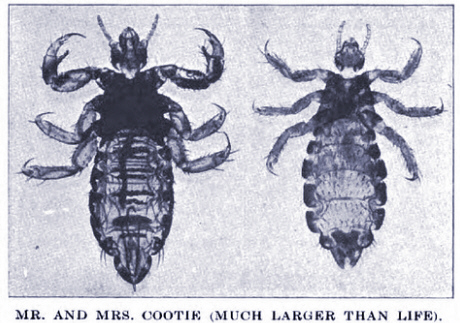
No Comment Needed
Fortunately for the trench-bound Allies, the Quartermaster Laundry Branch came to the rescue. By war's end, mobile laundry units (horse drawn and steam driven) moved closer and closer to the front. Such apparatus operating near the front had to be carefully camouflaged, as either smoke or steam led the enemy to believe they had discovered artillery batteries.
The delousing plants set up at Le Mans and other base ports were so elaborate that Doughboys termed them "mills". Entering "The Mill" dirty, weary, and disheveled, the soldier on his exit came out completely renovated both in clothing and body. So successful were these operations that within six weeks the incidence of lice infestation dropped to an amazing 3 percent! The U.S. Army discovered that with the right equipment, good planning, plus plenty of soap and water, it could lick an age old foe -- "Cooties".
|
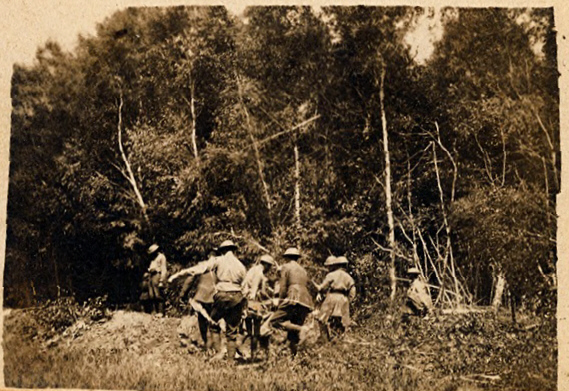
Burial Detail for First Sgt. Daniel Amos Hunter, USMC, at Belleau Wood
(contributed by Paul Higgins)
Read More at Bradley Omanson's History and Lore of the Old World War (link)
|
|
|
 |
A New Take on a Well-Covered Topic
Churchill's Dardanelles Strategy
|
Churchill's Dilemma: The Real Story Behind the Origins of the 1915 Dardanelles Campaign
By Graham T. Clews
Reviewed by Len Shurtelff
This is more than a new and controversial look at the failed Dardanelles Campaign. The author in a well-documented presentation asserts that First Lord of the Admiralty Winston Churchill never intended the Dardanelles attacks to be more than a naval attack, but favored instead one or another proposal to invade Germany along its North Sea coast. The Dardanelles became a victim of mission creep and the tardy reinforcement of ground troops committed when the naval attack failed.
Moreover, the forces committed to the Mediterranean stripped England of the men and ships needed to mount an attack against Germany through the Frisian Islands, Heligoland or Schleswig. Churchill's concept of a seaborne attack against Germany also involved subverting the neutrality or Holland or Denmark, which never happened. Many other abortive plans involving Serbia and Greece and attacks against Hungary from the south were also pursued by others, including Lloyd George and Lord Kitchener. Despite its naval dominance, the Royal Navy did not have the strength to contain the German High Seas Fleet while simultaneously maintaining both a distant and close blockade of German ports as envisaged by Churchill.
Churchill's dedication to the North Sea is demonstrated by his development a several classes of shallow-draft monitors for bombarding German defenses along the North Sea coast and for supporting army landings there. Some of the monitors served in WWII at Anzio and other amphibious landings. The remnants of German coastal gun emplacements are part of a museum complex open to the public south of Ostend, Belgium. Monitors (surely among the ugliest of warships ever launched) were also envisaged as supporting landings along the Belgian coast as part of the Third Battle of Ypres in 1917. The landings never took place, though a Royal Navy attack in 1918 did succeed in sealing off the naval German base at Zeebrugge for a time.
Churchill's Dilemma: The Real Story Behind the Origins of the 1915 Dardanelles Campaign, Graham T. Clews, Praeger, 2011, 343 + xx pages, photos maps, appendices, index, references, ISBN 978 0 3133 8474 5.
|
|
|
















